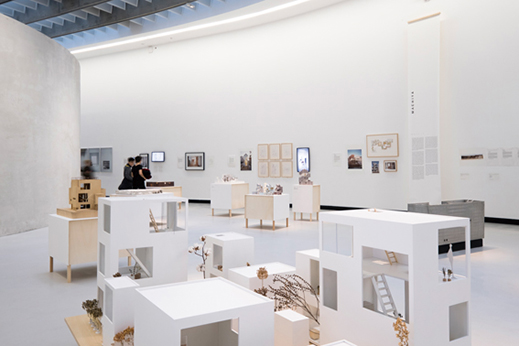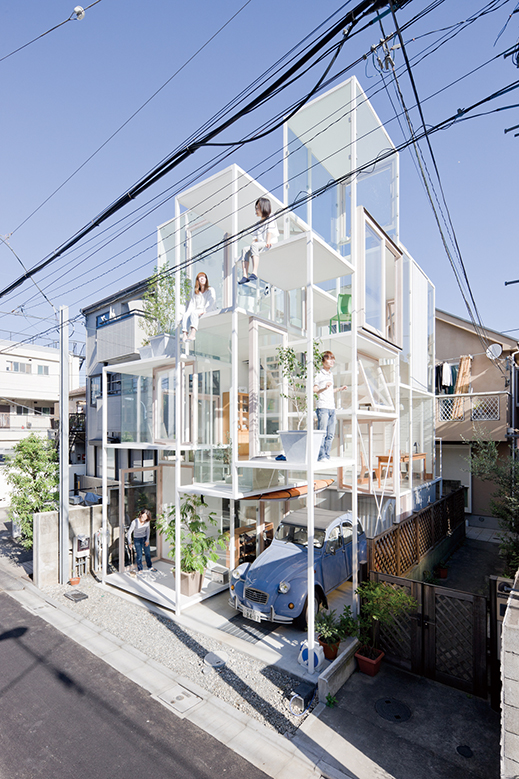 |
Focus features two in-depth reviews each month of fine art, architecture and design exhibitions and events at art museums, galleries and alternative spaces around Japan. The contributors are non-Japanese residents of Japan. |
|
|
 |
 |
 |
Dreaming Up the Japanese Home
J.M. Hammond |
 |
Terunobu Fujimori, Leek House, 1997. © Akihisa Masuda |
Since World War II, Japanese culture has gone through numerous transformations, not least in the realm of architecture. In particular, as Japanese people's basic modes of working, living and communicating with each have other changed, so have the houses they live in.
The Japanese House: Architecture and Life after 1945, showing until 29 October at The National Museum of Modern Art, Tokyo, posits 13 different concepts as reflective of the postwar situation, and looks at 75 different houses to illustrate them, through photographs, plan drawings and sometimes maquettes (small 3-D models). These 13 topics include mass production in the immediate wake of the war; a sensitivity to the sensorial aspects of architecture; and, particularly in recent decades, architectural responses to changes in family life and living patterns.
The exhibition is carefully curated by Kenjiro Hosaka of The National Museum of Modern Art, Tokyo, and Yoshiharu Tsukamoto of the Japanese architectural firm Atelier Bow-Wow, and has already enjoyed enthusiastic responses in London and Rome before coming to Tokyo.
Starting with the years immediately after the war, the exhibition introduces a number of Japanese house designs from the fifties and sixties. These are just one or two stories high and share a similar basic outline -- long and low. Many combine what are often seen as typical Japanese elements and materials, such as walls of wood and sliding partitions made of paper. A House with Chestnut Tree from 1956 is highlighted for its combination of Japanese and Western elements, as it includes both tatami-mat rooms and areas designed for chairs and other Western furnishings. Designed by Tsutomu Ikuta, the house includes an outdoor floor space that is similar to an open engawa veranda where it runs outside the Japanese-style rooms, but features a handrail, more in line with European balconies, outside the Western-style rooms. In this way the two modes of living are combined in one building, but remain separate.
 |
|
Kenzo Tange, A House, 1953. Courtesy of Michiko Uchida |
Kenzo Tange's two-story A House suspends the main living area above predominantly open space, supported by pillars and walls. This design and its air of openness and transparency recalls in some ways the tradition of raised shinden-zukuri buildings for the nobility of earlier days. In that sense, postwar buildings such as these can be seen as continuing a particular Japanese aesthetic -- one that was also to inform aspects of modern architectural theory, and style, in the West.
The exhibition is correct in pointing out, however, that this is only part of the story, and that a separate lineage of Japanese architecture going back to Jomon-era (c.14,000-300 BCE) pit dwellings was to evolve over time into minka and machiya -- houses for farmers and townspeople, respectively. In contrast to the suspended living quarters of the nobility, the earthen floors and walls of these structures meant their inhabitants lived closer to nature, not suspended above the dirt, but at the same time, the sturdy walls kept the elements firmly out.
Several relatively recent buildings illustrate the continuation of the minka and machiya styles into the modern period. One of these is Tadao Ando's Row-House in Sumiyoshi from 1976, which updates the machiya format in raw concrete, and in doing so comes closest among the designs in the exhibition to the Brutalist style that seemingly dominates discussions of 20th-century architecture. Following the owner's specific request, the building has only a few small windows, so is a largely stark, unwelcoming facade of bare walls. But the house is redeemed, if that is the word, by the open space in the center that gives it a sense of life.
Many of the houses discussed above were created for clients with the financial resources to build homes in locations with sufficient space to explore questions of architecture's relationship with nature, and with Japan's aesthetic tradition. But as the pressure was on to rapidly rebuild in the decades after the war, many other architects were less concerned with these questions than with the challenge of quickly erecting affordable housing in the limited spaces of Japan's urban centers. Highlighting this reality, a video screened at the exhibition reveals the process behind Kisho Kurosawa's modular concept for the landmark Nakagin Capsule Tower, built in the early seventies in Tokyo's Ginza district. For this unique project, factory-produced box-like units were attached one by one to the tower's steel frame as they were purchased, in an almost organic process of growth.
 |
|
Installation view in MAXXI, National Museum of the 21st Century Arts, Rome, 2016. © Simona Ferrari, courtesy of Atelier Bow-Wow |
The show goes on to explore changes to the architectural landscape since the bursting of Japan's economic bubble in the late eighties and early nineties. Long commutes to and from Tokyo were a daily grind for many of the previous generation, but with land prices now dropping, it became possible for relatively young buyers to purchase small parcels of real estate in prime areas and have architects design the kind of urban dwellings they would like to live in. Some of the solutions displayed here are intriguing, including one residence that actually consists of five discrete buildings of modest size, each with its own function, and incorporating the gaps between them into the life of the "house."
The exhibition also explores changing living arrangements and family dynamics. Riken Yamamoto's House in Okayama is divided into three buildings. One of these prioritizes privacy with separate living areas for husband, wife and child, while a kitchen and semi-outdoor communal space allow them to gather as a family. In contrast, Sou Fujimoto's unique design for a family home facilitates a sense of shared living. In T House, each family member has his or her own room, but these all fan out from a central communal space that everyone must move through to get to any other part of the house. And due to a deliberate choice not to have these "private" spaces closed off with doors, the open design further facilitates communication and interaction.
Another idea the show looks at is how architecture reflects changing conceptions of private and working life. Included here are a video and model of the headquarters of architectural firm Atelier Bow-Wow, which incorporates office space on the lower floors and living space for the company's boss on the higher levels.
The exhibition could have chosen to rely on the drawing power of some Japanese "starchitects" (a number of important figures are omitted), but by choosing to firmly focus on concepts and designs, The Japanese House not only introduces some lesser-known names but also some architectural gems that may otherwise have been overlooked.
 |
|
Sou Fujimoto, House NA, 2011. © Iwan Baan |
All images provided by The National Museum of Modern Art, Tokyo.
|
 |
 |
J.M. Hammond
J.M. Hammond researches modernity in Japanese art, photography and cinema, and teaches in Tokyo, including as a faculty lecturer in the English department at Meiji Gakuin University, and at Gakushuin University. He has written about art for The Japan Times for over a decade. His essays include "A Sensitivity to Things: Mono No Aware in Late Spring and Equinox Flower" in Ozu International: Essays on the Global Influences of a Japanese Auteur (Bloomsbury, 2015) and "The Collapse of Memory: Tracing Reflexivity in the Work of Daido Moriyama" for The Reflexive Photographer (Museums Etc, 2013) [reprinted in the same publisher's 10 Must Reads: Contemporary Photography (2016)]. He has given various conference papers, including at the University of Hong Kong and the University of Oxford. |
|
 |
|